How To Clean White Dripping Metal Deposits From Brick
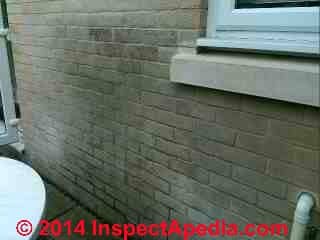 Stains on Brick Surfaces
Stains on Brick Surfaces
How to identify, clean, or forestall stains on brick surfaces, chimneys, walls, floors & on concrete block surfaces
- POST a QUESTION or COMMENT about the cause, removal or prevention of staining on brick surfaces
InspectAPedia tolerates no conflicts of interest. We have no relationship with advertisers, products, or services discussed at this website.
Stains & discoloration on brick surfaces:
This article describes the causes & cures for various types of stains plant on brick surfaces both outdoors and indoors. Nosotros list the mutual sources of stains on brick chimneys, walls, walks, and ceilings.
The article distinguishes among mutual brick stain sources such equally algae, leaner, lichens, moss, soot, sulphur, fungal growth, and other causes of markings on brick.
Nosotros also provide an ARTICLE Index for this topic, or you can try the page top or lesser SEARCH BOX as a quick style to find information you demand.
Stains on Brick Surfaces
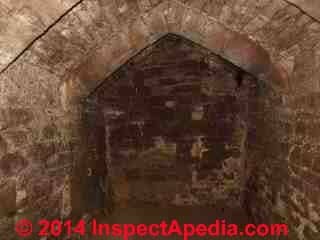
Commodity Contents
- STAINS on BRICK SURFACES
- BRICK CHIMNEY STAINS
- BRICK EXTERIOR WALL STAINS
- BLACK STAINS on BRICK
- Dark-green STAINS on BRICK - ALGAE
- RED STAINS on BRICK - RUST?
- WHITE STAINS on BRICK
- BRICK EXTERIOR CLEANING WARNINGS
- BRICK Exterior PATIO / WALK STAINS
- BRICK INTERIOR WALL STAINS
- BRICK SURFACE PAINT REMOVAL
- BRICK STAIN REMOVAL GUIDES
[Click to enlarge whatever image]
Photograph above, brick (and stone) staining in the dungeon at Goodrich Castle, Ross on Wye, Herefordshire, England, United kingdom.
Brick Chimney Stains
Beneath our photograph at left shows white gunk on the outside surface of a chimney.
This is almost certainly efflorescence, a mineral salt left behind as h2o leaks into and evaporates out of the brick chimney. The right-mitt photograph shows black soot staining at the peak and sides of a brick chimney. If this soot is from an oil fired heating appliance, a service call is needed.
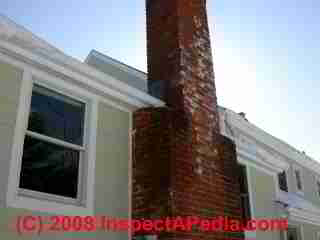
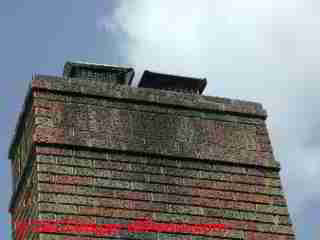
[Click to enlarge any image]
Run across EFFLORESCENCE SALTS & WHITE DEPOSITS for steps to cure efflorescence and to remove it from brick or other masonry surfaces.
Below we come across black or brownish tarry stains on the surface of a chimney visible in an attic. These are most likely creosote, or creosote mixed with soot that has leaked through openings in this antiquarian brick chimney and its flue. We hash out this chimney and what to do well-nigh it
at CHIMNEY STAINS, INDOORS
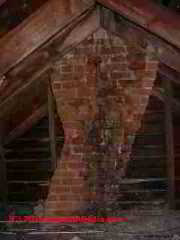
Encounter CHIMNEY STAINS & LEAKS for a catalog of stains appearing on, in or around all types of chimneys.
Watch out: water damage or soot, creosote, or other blockages of chimneys may make the chimney or flue dangerous.
See CHIMNEY INSPECTION DIAGNOSIS REPAIR
Stains on Brick Exterior Walls
Blackness, dark, or greenish stains on exterior brick

A reader asked us for an opinion of the cause of the light-green and black stains on this exterior brick edifice wall.
While a closer on-site inspection or in some cases a forensic lab analysis of a tape lift of the brick wall surface would be needed for certain identification, this looks much like black and green algae growing on the wall surface.
The reader noted that the night staining on this brick was occurring merely below an area where roof drainage was spilling down the building wall, and s/he asked for advice about how to clean this surface, and whether power-washing would be ok.
To minimize the chances of damage, we like to start cleaning with the most gentle approach first to see if that'southward sufficient.
Power washing may be OK on this mod hard-fired clay brick wall as long as the washer does non spray h2o into the wall crenel through weep holes or other openings.
More than black stains on an outside brick wall are shown only below. These are due to pelting-splash-upward from the lower roof onto the brick sidewall. The increased moisture level has encouraged algal growth on the brick surface.
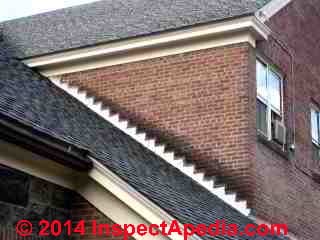
Green Stains on Exterior Brick Walls: Algae

Above the green stains on this structural brick wall (Vassar College, Poughkeepsie, New York, USA) are almost certainly an algae growth.

The wall is shaded and roof drainage organisation leaks take made this wall side particularly wet. Later, subsequently the roof drainage system had been repaired, this wall was renovated and portions of it that had been frost-damaged were re-built.
Common Causes of Light-green Stains on Brick Surfaces
- Algae, Lichens, Moss on brick
- Dark-green pigment on brick: identify as pant from nearby surfaces or building history
- Vanadium salt staining on brick: vanadium salts combined with acidic environments that may in plough exist due to use of muriatic acid or HCL to clean brick surfaces or in areas of acid rain tin can exit green crystalline salts on the brick surface. Stain may exist chartreuse in colour, dark-green, or yellowish-light-green.
Remove vanadium green stains: using chemical cleaners such as VanGo, Oxcid (followed by a neutralizing agent such as Neutril) IF the staining was not due to use of an acidic cleaner as we mention above;
Wallkleen may also work.
Light amplification by stimulated emission of radiation cleaning of moulds and rusts and oxides can work on artifacts but may non be toll-constructive for buildings.
Oxcid or Vital Oxide cleaner, various sources [citations needed]
VanGo, from ATCO International, 1401 Barclay Circle, SE Marietta, Georgia 30060-2925 produces a series of cleaners and paint and graffiti removers. one-800-723-2826 Website: https://www.atcointernational.com/prod-22-1-663-24/vango-ii.htm
Walkleen, from Sanosil, active foam cleaner, is an acidic facade cleaner. Sanosil A.Grand., Eichtalstrasse 49 CH-8634 Hombrechtikon Website https://www.sanosil.com/en/produkte/wallclean-s-fassadenreiniger-sauer/ excerpt:
Sanosil WallClean Due south is a powerful special active foam cleaner for pre-treating or cleaning façade surfaces infested with mould, algae or moss. Sanosil WallClean S does not contain any fungicides and is completely biodegradable in accordance with European directive 73/404/EEC relating to detergents and directive 73/405/EEC on biodegradability testing.
Sanosil WallClean Southward effectively removes oil and grease, limescale, wax residue, algae and found components, and soiling (mud, dust etc.). Particularly suitable for apply equally an active cream in conjunction with low-pressure foam applicators.
Question: why is my brick wall mortar turning green & what can I do about it
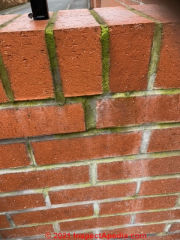
Tin can you please advise what I should practise almost my new garden wall? The mortar is starting to plow green. - Anonymous by private electronic mail 2021/03/31
Moderator reply: how to make clean & forestall algae growth on brick walls
The greenish in your photos is almost certainly algae, though there could exist some mold growing there likewise. The algae growth occurs "naturally" outdoors on wet masonry (and other surfaces), specially in a clammy or moisture climate and more than-so where shaded from sun exposure.
You tin can clean the algae using whatever of several cleaners that are discussed
at BRICK STAIN REMOVAL GUIDES
and also
at Rock, STUCCO & BRICK CLEANING METHODS - where there are also some prevention suggestions.
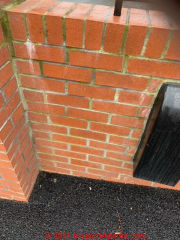
As well run across ALGAE & MOLD STAINS on EXTERIORS
A competent onsite inspection by an expert unremarkably finds boosted clues that would permit a more accurate, complete, and authoritative answer than we tin give by email alone. You will notice additional depth and detail in manufactures at this website.
Red Stains on Brick: Rust?
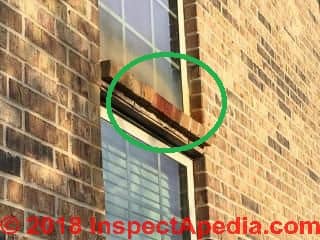 On 2018-09-16 1 past (mod) - diagnose and remove red stains on brick window sill
On 2018-09-16 1 past (mod) - diagnose and remove red stains on brick window sill
Mahmood
Regarding the dark scarlet stains on the center of the brick window sill in your photograph:
My all-time guess is that previously someone had a window air conditioner in the window in your photo and the A/C condensate rusted the air conditioner base and stained the brick equally information technology drooled down the building wall.
If the red stains on the brick sill are from rust, try an atomic number 26 or rust stain remover product.
The article STAINS on BRICK SURFACES discusses approaches to cleaning stains on brick too as preventing their recurrence.
If the red stains on the brick sill in your photo are algae (which seems less likely given the circumstances portrayed in your photo, but still, not impossible), just about any household cleaner may remove information technology; use plenty of rinse water to avoid any bleach staining of the bricks below.
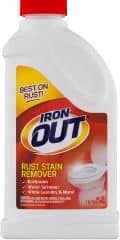
Sources of Ruddy Stains in or on Brick Surfaces (likewise black & brown)
- Manganese dioxide (MnO2) efflorescence: manganese dioxide inclusions in the brick (or mortar) may be dissolved by very soft rainwater or by use of muriatic acid (oft used to make clean mortar from brick surfaces after contempo masonry work). The alkaline chemistry of mortar may react with MnOii to form a brownish-red stain or or sometimes a black stain on brick.
Remove using a dilute acid such equally 0.01M Muriatic acid (HCL) and 3% Hydrogen Peroxide H2O2. Rinse thoroughly, promptly to avoid run-down stains.
Cream of tartar + hydrogen peroxide may too work.
- Ruby algae, lichens, mold stains: some algae (and some fungi or lichens) are red in color; correlate with moisture and shade.
Remove from brick using soft brush scrubbing (avoid power-washing that may damage brickwork) and any household cleaner or deck cleaner. Rinse thoroughly, promptly to avoid run-downwardly stains.
- Rusting metal components or hardware higher up the stain expanse such as iron window frames, declining galvanized atomic number 26 flashings, hardware such every bit shutter bolts or metallic fixtures, even atomic number 26 or cast-iron piping, railings, etc. above or near the brick surface.
Remove from brick using an atomic number 26 stain remover production. Rinse thoroughly, promptly to avoid run-down stains.
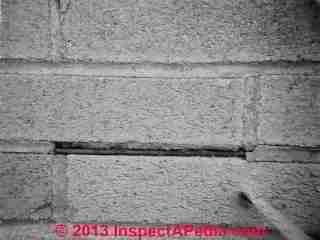
- Rusting metallic reinforcement in brick walls and chimneys such as iron wire, mesh, or re-bar too close to the surface of a mortar joint
Remove from brick using an iron stain remover product. Rinse thoroughly, promptly to avert run-downwardly stains. Re-mortar open up joints after sealing the exposed metal with a masonry-compatible bonding/agent or sealer or primer.
- Iron sulfide pyrrhotite inclusions in some bricks.
Remove from brick using an iron stain remover product. Rinse thoroughly, promptly to avoid run-downwardly stains. Re-mortar open joints after sealing the exposed metal with a masonry-uniform bonding/amanuensis or sealer or primer. - Doubtful that this will provide long term success. Contaminated brickwork may need to be removed and replaced.
Other brick surface cleaners that might work:
- Paste of dish soap or borax or TSP substitute and salt, 10 -xxx minute exposure, rinse thoroughly.
Also run into inquiry on red stains on buildings and crimson stain and atomic number 26 stain removal suggestions plant in these InspectApedia articles
FOUNDATION Impairment by Fabric or INCLUSIONS - red stains caused by inclusions of iron sulfide mineral (pyrrhotite) can announced in concrete and in some brick and rock materials.
RUST STAINS on ROOFS - examples of cerise rust stains from oxidizing corroding metal
STAINS on Stone, STUCCO DIAGNOSE & CURE - additional cleaning methods that can piece of work on brick
WATER SOFTENER IRON & SEDIMENT REMOVAL - more rust stain remover products
Our outer Brick walls few bricks stained forth with window glass from exterior due continuously dripping of A/C water. Kindly advice and assist how to clean stains from bricks and drinking glass.
The photo is shown above.
White Stains on Brick Walls: Efflorescence vs. Paint Paint Run-down vs. Mortar SNAFUs

Earlier we illustrated white efflorescence staining on a brick chimney, a common spot where efflorescence appears outdoors on masonry buildings. Our photo at in a higher place left, showing thick white deposits on a structural brick wall in New York (Vassar College) shows that efflorescence can show up anywhere that there are water leaks in or downwards brick walls.
See EFFLORESCENCE SALTS & WHITE DEPOSITS
But not all white stains on brick surfaces are due to efflorescence
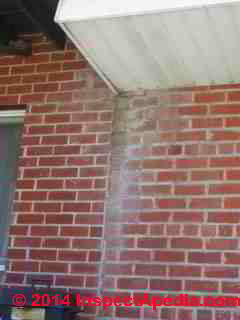
Above the white stains on this brick veneer wall were caused past leaks into the white coated aluminum soffit. White paint from the soffit has run downwardly the wall leaving a white deposit. There was a bit of green algae in the top area of this stain too.
Actually? Brick veneer? Yes.
Before y'all write to gripe that the minor brick-ends indicate a bond grade making this a structural brick wall let me explain that no, this is a brick veneer wall synthetic by a retired mason who took delight in making it look like a structural wall. The wall is actually a single wythe brick veneer fastened to a physical block structural wall.
Beneath we illustrate some other white area on a brick wall that is not due to water or leakage nor to pigment paint wash-down. .
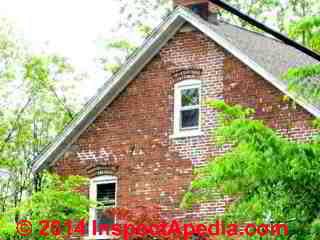
The white "stains" on the brick exterior wall shown above are not stains at all simply rather mismatched mortar used by a mason or an amateur who had trivial business concern for preserving this pre-1900 home in Dutchess County, New York.
The bricks in this wall were already spalling but the utilize of a harder mortar for the repair work is likely to accelerate the spalling harm to this home located in a freezing climate.
Question: are these white stains on brick efflorescence?
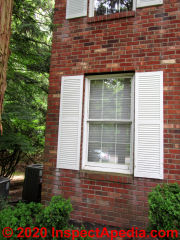 Delight see attached movie.
Delight see attached movie.
Is this efflorescence?
Is this the result of run off water from the exterior shutters?
I noted that like staining on brick surfaces on inspectapedia and information technology was recommended to utilize a TSP (equivalent) cleaning solution would you recommend that here too?
Thinking of recommending professional cleaning.
- Dov Ber Kahn, a home inspector in Rockland County, NY has contributed photographs of various building features. Mr. Kahn is a licensed domicile inspector in New York and tin can exist reached at Website: Kahnbhomeinspectors, Tel: 845-445-8234, Email: kdovber@googlemail.com
Moderator reply: white paint pigment - oxidized paint runs down onto & stains brick veneer
Notice the pattern of white staining is most notable immediately below the edges of those white-painted shutter?
Most-likely it's white paint paint runoff from the shutters.
In that location are some whitish bricks that may each be producing their ain personal patch of efflorescence - take a closer look at
Brick wall stain removal past cleaning, power washing, sand-blasting: warnings
Watch out: Experts similar Grimm (1990) widely warn against sand-blasting to make clean brick surfaces of buildings. That ambitious arroyo amercement the brick and mortar and tin lead to rapid deterioration of the wall.
Furthermore, on antique, soft brick, even power washing can remove the brick's harder-fired surface, leaving the softer brick interior vulnerable to h2o and frost damage and causing plush building damage.
Power washing can also remove older soft mortars. And even on the modern hard dirt brick wall, the washer needs to exist used with care, starting from a more than afar position in order to avoid leaving likewise-calorie-free power-sprayer marks on the wall.
Extra intendance must be taken if cleaning a brick-veneer wall as there may exist more weep openings or leaks around window or door penetrations through which water may exist inadvertently sprayed into the wall cavity.
Other brick wall cleaning methods such as using lasers, photocatalytics, or special cleaners are discussed both at
the REFERENCES for this article
and
at STONE, STUCCO & BRICK CLEANING METHODS
Stains on Outside Brick Floors, Patios, Walks
At below left the black stains on this exterior brick patio located in New York state are probably algae but might too be a fungus. We'd need to examine a sample in the lab. At below right we see moss growth on the same brick patio in a nearby area.
This is a shaded brick patio constructed in the tardily 1990's. As plantings grew and a shade tree's canopy began to proceed more of the patio surface area in shade in summer months the surface area covered by algae, moss, and maybe fungi has grown.
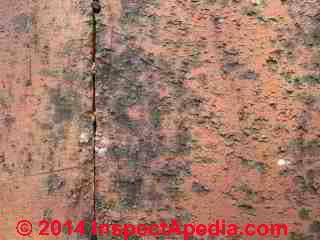
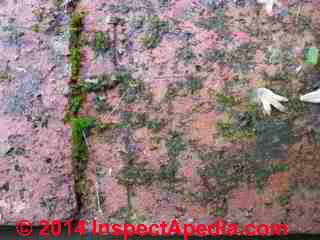
Remedies to reduce the staining on the brick shown in a higher place include assuring proper drainage, increasing the sun exposure by judicious pruning, sweeping off organic debris that agree h2o on the surfaces (leaves), and occasional ability-washing.
Watch out: algae and moss on a brick walking surface or on any walking surface for that matter, are very slippery and risk a skid-trip-autumn injury.
Encounter SLIPPERY STAIRS, WALKS, ROOFS for the static coefficient of friction of various slippery walking surfaces.
Below we illustrate outdoor brick patio or walk surfaces that are not slippery with algae, moss, fungi.
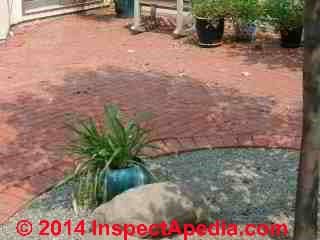
Below we illustrate that a brick walkway, even 1 built using antiquarian bricks that accept been in place for more than 50 years do not accept to be slippery with algae, moss, nor fungi. The Dutchess County New York brick walkway shown above is in a sunny area and is well drained.
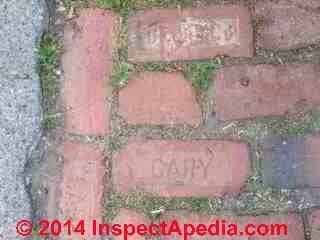
However the holding manager does need to keep alarm for frost-heaved or cleaved bricks that might form a trip hazard.
Stains on Interior Brick Wall, Ceiling, or Floor Surfaces

Above at left, detect the night stains on the rear wall and white efflorescence stains on the ceiling of the dungeon at Goodrich Castle, Ross on Wye, Herefordshire, England, Uk.
Both of these stain sets can exist ascribed to water entry, but we also observed moss and even some fungi growing on these walls.
Below are very black creosote and soot stains on the hearth-face of a stone fireplace installed in a hand-built log cabin at Elk Lake Michigan.
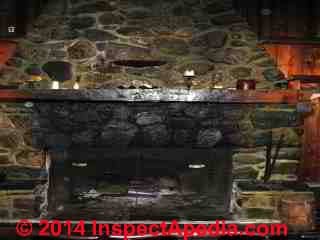
Also see STAINS on INDOOR SURFACES, Photo GUIDE.
Finding and fixing leaks into or onto brick structures is a key step in stopping the formation of algae, moss, efflorescence, or fungal staining on brick surfaces.
How to Remove Paint from Brick or Stone Surfaces
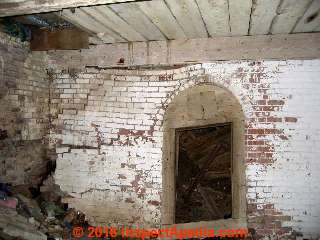
Here is a summary of good practices when you need to remove whatever blazon of pigment from an exterior or interior brick wall, fireplace, or other surface. These methods also work well for stone surfaces.
[Click to enlarge any epitome]
Question: How do I clean off paint run-down from white siding on brick
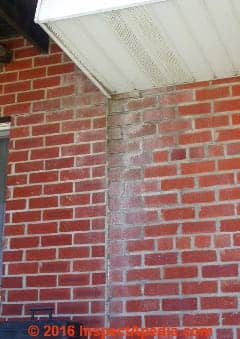
1 June 2016 dennis said:
how exercise i clean pigment pigment run downwardly from white siding on brick
Reply:
Dennis,
How to Remove Paint Chalk Rundown from Brick Surfaces
If you are asking only about the simple deposits of runoff from a chalking painted surface, I recommend gentle cleaning of the brick with a natural bristle brush and a TSP substitute cleaning solution.
You can also endeavor household detergent. Please see our warnings below about the dangers of aggressive cleaning or power washing of brick surfaces.
Don't waste time trying bleach as some of our readers did. Bleach won't remove white paint paint and bleach itself, running down edifice surfaces can leave white streaks if non done-off quickly enough.
How to Remove Bodily Paint or other Coatings from Brick Surfaces
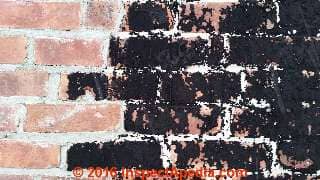
Before starting, for best results in brick surface cleaning you need to know
- The kind of paint you want to remove, as paint chemistry defines what solvents work best on information technology - latex is different from alkyd or old oil-based pigment.
I experiment with lather and water, mild cleaners such as vinegar, even dish soap or TSP substitute, and for some paints I might try lacquer thinner, odorless paint thinner, and peel-away paint stripping coatings.
In the photo above nosotros come across thick black blanket on office of a brick outside wall of a Vassar Farm building in Poughkeepsie, NY, USA.
This is tar, not paint. Virtually pigment removal treatments volition just make a mess on this surface.
- The amount of pigment to be removed, as a small-scale scale cleaning project may take a different approach from cleaning an entire brick (or stone) surface that has been painted over.
A large expanse project is going to require drop cloths, protective gear, and probably two stages of chemical stripping followed by gentle castor and wash cleaning of the brick surface.
- The nature of the brick (or rock) surface - as glazed brick or hard stone is easier to clean with solvent while soft brick or soft stone such equally brownstone or sandstone are at adventure of absorbing solvent-borne pigments.
Soft brick and mortar also blot more h2o and are at greater adventure of frost damage if soaked right before freezing weather.
So I don't think there is a unmarried "right" answer that's optimum for all conditions.
Brick Cleaning Mistakes to Avoid
Watch out: For people who are going to jump to "how to" let's first warn off some mistakes that you'll regret:
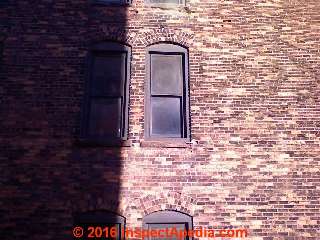
- I'd avert power blasting brick with sand or grit as that damages the brick, and even power washing with water tin can damage some brick and some mortar.
Blasting or power washing can remove the glazed surface of brick thus causing it to deteriorate rapidly from subsequent rain and in cold climates frost. Much has been written warning about too-ambitious cleaning methods on historic or older buildings, as you'll see in our citations below. The desperately-spalling wall of this Brooklyn NY building may have been damaged by sandblasting.
- I'd be careful to experiment with solvents before making a mess on the surface.
I scrape off thick coatings with a abrupt scraper, then endeavour scrubbing minor areas of run-down with a toothbrush, rinsing liberally and frequently before the solvent borne pigment soaks into the surrounding brick.
- Cold weather alarm: I avoid soaking brick and mortar with h2o or starting any paint removal project when freezing weather is imminent, so at present in the spring (if you're north of the equator) is a good time to scrub the surface using a stiff brush and the mildest solvent that works on the paint.
- I as well avoid muriatic acid equally it's non a good pigment solvent (and is dangerous to work-with). Hydrochloric acid is good for cleaning mortar from brick or stone surfaces as a last step when repairing or re-pointing masonry.
- Bottom line objective when removing paint from brick: avoid dissentious the brick such as by removing a hard glazed surface, avert using very volatile solvents that carry pigment into the brick surface, and exist very careful about personal protection from chemicals, lead, dust, etc.
Test your stripping or cleaning procedure in a small, less-obvious area before tackling the master painted brick area.
Recommended Paint Removers or Cleaners or Strippers for Brick or Stone Surfaces
Choose a pigment removal method that suits the amount of pigment, type of pigment, and status of the brick or stone itself. A peel away pigment remover may also work on some masonry surfaces.
Try Citri-Strip for a less-toxic cleaner that may piece of work on your paint. Newer peel-away chemical pigment remover systems that utilize a fabric + thick paint-on chemic paste tin can pull pigment off of the brick.
- Ready the work site: Put down 6-mil poly to take hold of paint and drippings safely while avoiding contaminating soil below the wall.
- Gear up the workers: Wear protective gear appropriate for the chemicals used.
Some pigment stripping chemicals are carcinogenic, some can cause unsafe burns or centre damage, some produce harmful VOCs and may require use of a respirator.
Old paints contain lead that can poisonous substance workers who don't protect confronting dust or fumes.
- Apply the strip or cleaning solution. If you are using a peel away method, basically you put down drop material, glaze the surface, apply fabric strips, wait, peel away the fabric that carries abroad virtually of the pigment.
- Final cleanup: Launder / clean the brick surface after the main torso of paint has been removed. Even after using the paint stripper you will probably have to practice some boosted gentle scrubbing on the brick surface as some pigment may remain.
- Dispose of waste product: Read the disposal recommendations from the manufacturer of the chemical or paint stripper you are using before starting the job. Pb pigment chips or debris may also require special handling, wrapping, disposal.
Take a look at some of the brick cleaning references I volition cite beneath, specially work where Grimmer was involved.
Guides for Removing Pigment & Stains from Brick Block or Rock Surfaces
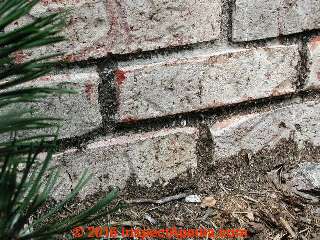
- STONE, STUCCO & BRICK CLEANING METHODS - DIY cleaning methods for masonry surfaces, at InspectApedia.com
- Ashurst, Nicola. Cleaning Historic Buildings: Five. 2: Cleaning Materials and Processes. Routledge, 2015.
- Brick Industry Association (BIA), CLEANING BRICKWORK [PDF] in Technical Notes on Brick Construction, August 2018, BIA 12007 Sunrise Valley Drive, Suite 430, Reston, Virginia 20191 |USA retrieved 2019/08/xvi, original source: http://www.gobrick.com/docs/default-source/read-research-documents/technicalnotes/twenty-cleaning-brickwork.pdf world wide web.gobrick.com | 703-620-0010
- Brick Found of America. "Cleaning Brick Masonry." Technical Notes on Brick Structure (No. 20) rev., Nov, 1990.
- The Masonry Establish of America - https://www.masonryinstitute.org/
- Clifton, James R., and K. Godette. "Operation tests for graffiti removers." In Cleaning Stone and Masonry. ASTM International, 1986.
- Daniels, Alva Due east., John R. Kominsky, and Patrick J. Clark. "Evaluation of two lead-based paint removal and waste stabilization technology combinations on typical exterior surfaces." Periodical of hazardous materials 87, no. 1 (2001): 117-126.
- Grimm, Clayford T. REMOVING STAINS from BRICK [PDF] Magazine. Masonry Constr. three, no. iii (1990): 117-121.
- Grimmer, Anne Due east. Dangers of abrasive cleaning to celebrated buildings. [Department of the Interior], Heritage Conservation and Recreation Service [Office of Archeology and Historic Preservation], Technical Preservation Services Division, 1979.
- Grimmer, Anne E. Keeping it clean: removing exterior dirt, paint, stains and graffiti from historic masonry buildings. DIANE Publishing, 1992.
- Liu, Katherine, and Elsa Garmire. "Paint removal using lasers." Practical eyes 34, no. 21 (1995): 4409-4415.
- Mack, Robert C., and Anne Eastward. Grimmer. Assessing Cleaning and Water-Repellent Treatments for Historic Masonry Buildings. Vol. one. Government Press Function, 2000.
- The states GSA Removing [Chocolate-brown] Manganese Stains from Brick Masonry [PDF] U.Due south. General Services Administration, retrieved 2020/12/14
- US GSA Removing Smoke STAINS From BRICK MASONRY [PDF] U.Due south. General Services Assistants, retrieved 2020/12/14
- US GSA Removing [YELLOW GREEN] Vanadium Stains from Brick Masonry [PDF] U.S. General Services Administration, retrieved 2020/12/14
Extract:
This procedure includes guidance on removing xanthous or green stains from brick masonry resulting from deposits of vanadium salts on the masonry surface. B. Vanadium staining is a form of efflorescence that originates in the raw cloth used to manufacture sure brick units.It develops when moisture in the wall draws salts and color from the brick composition to the surface of the masonry. As the water evaporates, vanadium staining is left behind.
- US GSA Removing Clay from BRICK MASONRY [PDF] U.Due south. General Services Administration, retrieved 2020/12/14
- United states GSA CHEMICALLY REMOVING Paint FROM and REPAINTING BRICK MASONRY [PDF] U.S. General Services Administration, retrieved 2020/12/xiv
Extract:
This procedure includes guidance on chemically removing pigment from and repainting brick masonry.Notation: Sandblasting is non recommended by the secretary of the interior's standards for rehabilitation and shall not be used. High-pressure water blasting is also not recommended without adequate testing or experience equally it may erode soft brick and drive moisture into the wall.
- United states of america GSA GENERAL CLEANING of EXTERIOR BRICK MASONRY [PDF] U.S. General Services Administration, retrieved 2020/12/xiv
Extract:
The work specified herein requires knowledge of older materials and methods and a high caste of skill to execute properly. This work should be performed only by an experienced, pre-qualified contractor. It is non recommended that building maintenance personnel perform this work. - US GSA Poulticing Copper/Bronze Stains from Brick Masonry [PDF] U.S. General Services Assistants, retrieved 2020/12/xiv
- US GSA POULTICING RUST STAINS FROM LIMESTONE AND MARBLE [PDF] U.S. General Services Administration, retrieved 2020/12/xiv
Excerpts:
This procedure includes guidance on removing rust stains from limestone and marble by poulticing using different chemical solvents or by using a paste containing a commercial rust remover.Note: THIS PROCEDURE MAY ALSO Be USED FOR REMOVING RUST STAINS FROM BRICK MASONRY.
Metallic stains from atomic number 26 or steel accept the appearance of rust. This type of staining is often caused by the run-offfrom flashing, gutters, statuary and fasteners. The source of the rusty runoff should be determined and cause abated. Cleaning should be undertaken after rectifying deficiencies causing the rusting.
- US GSA REMOVING SALTS / EFFLORESENCE from BRICK & Rock MASONRY [PDF] U.S. General Services Assistants, retrieved 2020/12/fourteen original source: https://www.gsa.gov/ technical-procedures/ making-solution-removing-beverage-soot-tar-and-other-stains-concrete?Form_Load=88552
- The states GSA [PDF] U.S. General Services Assistants, retrieved 2020/12/14
- Beloin, Norman J., and Fred H. Haynie. "Soiling of building materials." Periodical of the Air Pollution Control Association 25, no. 4 (1975): 399-403.
- Brocken, Harold, and Timo G. Nijland. "White efflorescence on brick masonry and concrete masonry blocks, with special emphasis on sulfate efflorescence on concrete blocks." Construction and Building Materials xviii, no. five (2004): 315-323.
- Bryant, Terry. "Protecting Exterior Masonry from H2o Damage: Moisture Control Procedures & Products." Engineering science & Conservation, Spring 1978, pp. 38-42.
- Cotton, J. Randall. "Blasted... Now What?" The Old-Business firm Journal, Jan/February 1987, pp. 38-41.
- Dajnowski, A. "Laser cleaning of the Nickerson Mansion: The first building in the The states entirely cleaned using laser ablation." In Lasers in the Conservation of Artworks: Proceedings of the International Briefing Lacona VII, Madrid, Spain, 17-21 September 2007, vol. three, p. 209. CRC Press, 2008.
- Grimm, Clayford T. "Don't sandblast brick." The Magazine of Masonry Construction (1990): 115-116.
- Grimmer, Anne E. Keeping information technology clean: removing exterior dirt, pigment, stains and graffiti from historic masonry buildings. DIANE Publishing, 1992.
- Grimmer, Anne E. Dangers of Abrasive Cleaning to Celebrated Buildings. [Department of the Interior], Heritage Conservation and Recreation Service,[Office of Archaeology and Historic Preservation], Technical Preservation Services Division, 1979.
- Grimmer, Anne E. Keeping It Clean: Removing Exterior Dirt, Paint, Stains, and Graffiti from Historic Masonry Buildings. Washington, D.C.: U.Due south. Dept. of the Interior, National Park Service, Preservation Help Division. 1988.
- Heidelmann, Hendrik. "Voruntersuchungen zum Zustand der Architekturteile und des plastischen Zierats des Sandsteinbaus der Kunstakademie Dresden." Arbeitsblätter für Restauratoren. Gruppe 6. Stein 27, no. ii, Gruppe six (1994): 313-318.
- Hocken, Jörg, and Bernd Proft. "Clean surfaces past utilization of the photocatalytic consequence." (2003).
- Ma, Guang-You, Lin-Yan He, and Xia-Fang Sheng. "Characterization of bacterial community inhabiting the surfaces of weathered bricks of Nanjing Ming city walls." Science of the Full Environment 409, no. 4 (2011): 756-762.
- Preston, John. "The surface restoration of buildings–An investment in the nowadays as well as in the time to come." Structural Survey 7, no. four (1989): 450-460.
- Rozniakowski, Kazimierz, Piotr Klemm, and Agnieszka J. Klemm. "Some experimental results of laser beam interaction with surface layer of brick." Building and Environs 36, no. 4 (2001): 485-491.
- Shahidi, Salman, Stéphane Mérillou, and Djamchid Ghazanfarpour. "Phenomenological simulation of efflorescence in brick constructions." In Proceedings of the First Eurographics conference on Natural Phenomena, pp. 17-23. Eurographics Association, 2005.
- STAINS on STONE, STUCCO DIAGNOSE & CURE
- U.S. GSA REMOVING BIOLOGICAL GROWTH FROM Exterior MASONRY AND STUCCO [PDF] (2018) U.S. Full general Services Administration, retrieved 2020/12/14
Excerpt: This procedure includes guidance on removing biological growth such every bit lichens, algae, mold and mildew from masonry and stucco. B. Biological growths such as lichens, algae, moss and fungi growing on masonry walls is usually an indication that there is excess moisture in or around the masonry. These growths should be removed, as they attract moisture to the masonry surface and hold it at that place, which can pb to more serious bug. Lichens and mosses in detail, produce oxalic acrid which can damage certain types of historic masonry.
- U.S. GSA REMOVING CLIMBING PLANTS AND CREEPERS FROM MASONRY [PDF] (2018) U.Due south. Full general Services Administration, retrieved 2020/12/14
Excerpt:
This procedure includes guidance on removing climbing plants from masonry.It is important to remove heavy vegetative growth from masonry, as its presence can pose many problems, such as property moisture confronting the masonry surface, blocking gutters and downspouts, scouring soft wall surfaces, eroding mortar and hindering or limiting admission for maintenance inspections and repairs.
- U.S. GSA REMOVING COPPER-BASED STAINS FROM BRICK, CONCRETE AND LIMESTONE [PDF] (2018) U.S. General Services Assistants, retrieved 2020/12/14
Excerpt:This specification provides guidance on removing copper staining on exterior brick, physical and limestone.
Remove soiling, stains and crusts from the limestone and granite without dissentious underlying material and to give all rock a make clean, uniform appearance without blotches, streaks or other irregularities. Use the gentlest means to meet the cleaning objective.
If the exterior masonry has been previously subjected to inappropriately harsh and uneven cleaning, information technology is expected that the cleaning volition reveal the original colors and textures of the brick, but that it will not completely correct the differential effects of the previous cleaning. Clean brick to remove soiling, stains and crusts to the extent feasible without further damaging the brick.
- U.Southward. GSA REMOVAL OF FERROUS STAINING FROM BRICK, GRANITE, Concrete AND LIMESTONE [PDF] (2018) U.Due south. General Services Assistants, retrieved 2020/12/fourteen
Excerpt:This procedure includes guidance on removing ferrous staining from exterior brick, concrete and limestone surfaces.
Remove soiling, stains and crusts from the limestone and granite without damaging underlying material and to give all rock a make clean, uniform appearance without blotches, streaks or other irregularities. Use the gentlest means to meet the cleaning objective.
If the exterior masonry has been previously subjected to inappropriately harsh and uneven cleaning, it is expected that the cleaning volition reveal the original colors and textures of the brick, but that it will non completely correct the differential effects of the previous cleaning. Clean brick to remove soiling, stains and crusts to the extent feasible without further dissentious the brick.
- U.South. GSA REMOVING PAINTED GRAFFITI FROM MASONRY [PDF] (2018) U.S. Full general Services Administration, retrieved 2020/12/14
Extract:
This process includes guidance on removing painted graffiti from historic masonry (this includes spray paint and paint-based felt-tipped markers).Successful removal of graffiti from masonry is dependent upon the type and surface texture of the masonry as well equally the item substance applied.
Reader Q&A - also see the FAQs series linked-to beneath
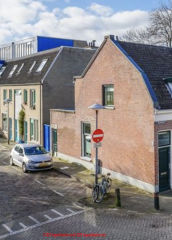 Information technology would be expected that over its life some of the brickwork on a century-old building has been re-built, particularly over that door lintel, also in areas prone to water damage;
Information technology would be expected that over its life some of the brickwork on a century-old building has been re-built, particularly over that door lintel, also in areas prone to water damage;
Moisture seeping into brick will often produce a white effloresence; and then we'll see at least three brick colours and may on closer inspection see differences in the mortar mix or even tooling details at the mortar joints - supporting an understanding of the building'south history.
Nighttime brownish or black stains I run into in an area beneath the patio wall / apartment roof parapet wall are often algae or on occasion, a mold that's invited where there has been extra wetness - perhaps from a leaky parpet capstone covering.
You will want to be sure that in that location are no leaks into the wall structure particularly from the patio roof above. Very oft when we meet white stains on brick is efflorescence from wet. Y'all can read about that in this article series.
[Click to enlarge any epitome]
The building is in Utrecht, kingdom of the netherlands and was built around 1900-1920. Indeed the height left corner seems as if were totally different brick.
The stain I consider the darker patch around 2m high and it seems to be getting a niggling lighter towards the lesser (colour matches the rest of the building in that location).
Could very well be just some unfortunate choice of placing dissimilar colored bricks.
It was built 100 year ago approx.
Delight feel free to post it. I believe asking a builder to clean the brick would not injure even if it would resolve the divergence in color.
Perhaps I'll try to get some brick friendly plants/English ivy.
[Click to overstate any image]
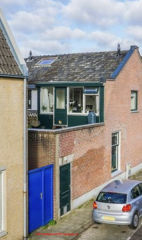 Ok now, which is the area that you are considering the stain? the darker brick, or the whiter brick?
Ok now, which is the area that you are considering the stain? the darker brick, or the whiter brick?
It looks as if a portion of the wall has been re-built.
Where is this building and what is its age?
What is the history of repairs to the surface of the patio-roof?
It is a roof terrace. I'll try and get you more pictures. On the indoor on the ground floor is the bath but I did not see dampness there. It also was renovated recently.
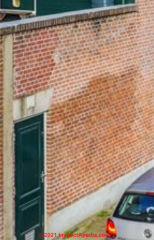 I see
I see
- dark stains just below a wall tiptop coping that looks like a roof parapet wall
- areas where mortar is more-white than others
- areas of more than-red brick over a door, probably a repair or reconstruction
- surface area of redder brick below whiter brick that may likewise exist an area of prior repairs.
I would need some more photo showing more of the edifice, at a distance so I can get some perspective in context, also what's higher up, is that a flat roof?
Howdy! I can't figure out why there's a discoloration on the brick of my house I merely bought. [Photo in a higher place]
Thanks
Eva
I hope you lot are keeping well in these strange times! I wonder if yous have an idea why the below brick wall is discolored (if helpful, on the inside it'south a recently renovated bath). Is there any style to set up it ?
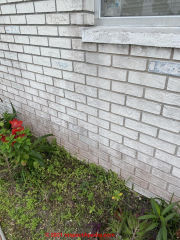 @MC,
@MC,
The most probable cause of the discoloration of brick on your veneer wall shut to the basis is rain splash-upward, caused, in turn by spillage of h2o from the roof border.
The proper solution, if that's the case is to make sure that the gutters are cleaned and properly sloped and draining away from the house and not spilling over into that area.
When you've taken intendance of that it would make sense to clean the brick surface and if the paint has actually come off of the brick and then y'all'll need to repaint the bricks.
I have a brick confront facade on my home. I believe it has a white wash stop.
At that place are red dark-brown stains on it. When it gets wet, you can literally see a what appears the red brick from underneath. I would like to apply sealer just fearful that the red colour of brick volition stay permanently on the surface.
Is there anything I can do for remedying the staining and waterproofing information technology somehow so that there is no discoloration when information technology gets moisture ?
Effort gentle brushing with vinegar or other household cleaners; rinse thoroughly
A hibiscus bush with big ruddy flowers greww nest to a newly painted white brick wall, I tried to remove the dried leaves with a sponse and h2o and information technology allow i light dark-green stain. How tin i remove the stain so the brick volition render to white colour
That is weird, David. Try attaching a sharp photo or several (ane per comment)
I have a weird consequence on the outer brick wall of my house. It is a clear substance--completely transparent--that looks like very thin melted plastic adhering in irregular patterns, almost like it was dripped and pooled in random patterns.
At first I thought perhaps a pocket-sized clear piece of plastic had melted on the bricks--but then more of the stuff showed upwardly afterward the previous spots had started to fade
. I'yard pretty sure no 1 is deliberately doing it in the night. So far my best guess is maybe some kind of pollen or sap is being diddled and splattered occasionally on that wall. Haven't plant information technology on any other wall. I am really perplexed as to what it might be. Whatever thoughts?
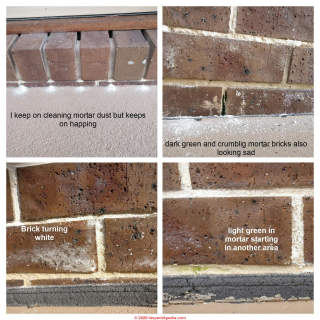 Marie
Marie
Thanks for the interesting photos and question about mortar deterioration in your brick veneer wall.
I remember we take a combination of leaks into the wall
(see those openings in the mortar joints in your photo at superlative left?)
and perhaps variations in the mortar mix.
Start by finding and sealing leaks into the veneer wall.
Why only in a couple of expanse of our abode merely both under cover do i have the mortar turning to dust and in some places turning green.
Likewise a brick is turning white.
Please aid, How tin I treat this.
There are several commercial iron-stain removers such as Atomic number 26-Out that may work. Try offset in an unobtrusive spot.
Iron h2o stain on brick(boat house). What is the safest chemical and environmentally friendly with plants past the wall?
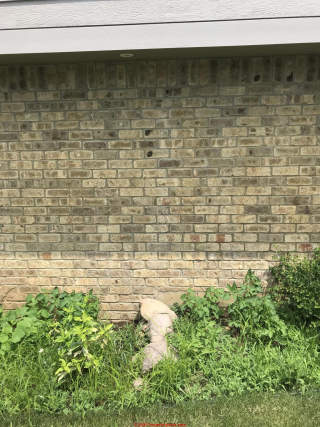
Liz
After cleaning off the soot or creosote,
and having the flue inspected for burn down-safety,
be certain the chimney is tall plenty - 2 ft. to a higher place the ridge or 2 ft higher up point of contact with roof surface of a horizontal line drawn from chimney peak to touch the nearest roof surface;
Inquire your chimney sweep if your chimney has the right type of cap - preventing downdrafts;
I'm reluctant to rely on a larger cap since nosotros'll just move the stain from the chimney to the roof surface, so we're left with taking care to burn dry, low-sap wood at sufficient temperature.
How tin I forestall a black stain on the outside of my house but beneath the chimney I take a forest burning stove
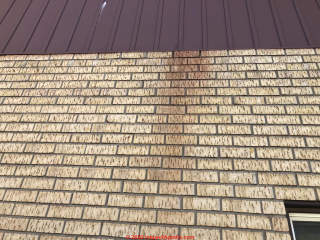 Gabriel
Gabriel
Two approaches to removing the reddish stain on your brick are
1. try some masonry cleaners or iron removers equally discussed in the commodity above
2. check out the list of likely causes of reddish stains on brick - too in the article above - to see if, past narrowing down the probable cause of the reddish stains in your photo we can home in on the well-nigh-effective cleaner
3. inspect the building, rooftop to siding bottom, including interior, plumbing, mechanical systems, to find the leak or defect that is causing this stain to appear in this item location.
In my view this is an important step as otherwise we don't know that the stain isn't simply a telltale of a more-serious hidden problem.
It seems that my aluminum siding has run into my bricks. Not certain if information technology'southward rust or just the siding color. How-do-you-do do I safely have off without compromising the brick color?
Thanks
Hullo, it seems that my brown aluminium siding is running down on my bricks. I'1000 non sure if it's rust or just the colour of the siding. Any suggestions how to accept it off without compromising the color of the bricks
...
Continue reading at Rock, STUCCO & BRICK CLEANING METHODS for cleaning approaches useful for brick or stone surfaces, or select a topic from the closely-related articles beneath, or come across the consummate Article INDEX.
Or come across STAINS on BRICK SURFACES FAQs - questions and answers posted originally on this page.
Or see these
Stone & Masonry Stains & Cleaning Articles
- CHIMNEY STAINS & LEAKS
- CHIMNEY STAINS, INDOORS
- EFFLORESCENCE SALTS & WHITE DEPOSITS
- MASONRY CLEANERS
- MOLD APPEARANCE - STUFF THAT IS NOT MOLD for other discolouration plant on brick surfaces.
- STAIN DIAGNOSIS on Building EXTERIORS - home
- STAINS on BRICK SURFACES
- STAINS on CONCRETE
- STAINS on INDOOR SURFACES, Photograph GUIDE
- STAINS on SANDSTONE, DIAGNOSE & CURE
- STAINS on Rock, STUCCO DIAGNOSE & CURE
- STONE, STUCCO & BRICK CLEANING METHODS
- Stone SURFACE CLEANING & ORGANIC GROWTH PREVENTION (Algae, Fungus, Lichens, Moss) from Stone, Brick, or Concrete Surface
Suggested citation for this web page
STAINS on BRICK SURFACES at InspectApedia.com - online encyclopedia of building & environmental inspection, testing, diagnosis, repair, & problem prevention communication.
Or meet this
INDEX to RELATED ARTICLES: ARTICLE INDEX to Building STAINS
Or use the SEARCH BOX institute below to Ask a Question or Search InspectApedia
...
Enquire a Question or Search InspectApedia
Try the search box simply beneath, or if yous adopt, post a question or comment in the Comments box below and nosotros will respond promptly.
Search the InspectApedia website
Note: appearance of your Comment below may exist delayed: if your comment contains an image, spider web link, or text that looks to the software as if it might exist a web link, your posting will appear later on it has been approved by a moderator. Apologies for the delay.
Technical Reviewers & References
Click to Testify or Hide Citations & References
Publisher InspectApedia.com - Daniel Friedman
Source: https://inspectapedia.com/exterior/Stains_on_Brick.php
Posted by: lewisthened.blogspot.com


0 Response to "How To Clean White Dripping Metal Deposits From Brick"
Post a Comment